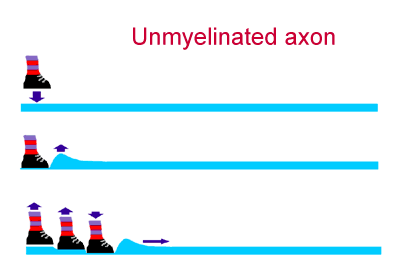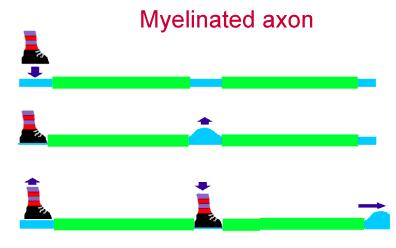Saltatory Conduction
This page offers a metaphor for understanding how myelin speeds up the propagation of action potentials.
There should be animated cartoons here (swf files), to make the description more intuitive.
Hopefully these animations will one day reappear at this site (as gif files).
Imagine a very long, thin water-balloon lying on the ground in front of you. The balloon represents an UN-myelinated axon.
- Stomp your foot on the balloon. The resulting pressure pulse corresponds to a localized voltage change (action potential) caused by opening of voltage-dependent sodium channels.
- The balloon will bulge out beside your foot. The bulge will be largest / strongest immediately adjacent to the spot where you stomped and will spread as a dissipating wave along the length of the balloon.
- The amount of bulging will decrease with distance, as the pulse
of pressure is absorbed by the elasticity of the balloon.
 Animation courtesy of Oscar Moya and Ben King
Animation courtesy of Oscar Moya and Ben King - You can "chase" the bulge down the balloon, if you stomp again
with your other foot before lifting your first foot and then continue this
side-by-side stomping all the way along the balloon. This repeated
stomping corresponds to continuous regeneration of an action potential along
an unmyelinated axon.
Animation courtesy of Oscar Moya and Ben King
Now imagine another water-balloon enclosed within long, tight-fitting segments of pipe. In between the segments of pipe are short stretches, about as wide as your foot, where the balloon is naked. Now the balloon represents a myelinated axon; the pipe is myelin and the short naked stretches correspond to nodes of Ranvier.
- Once again, stomp your foot on the balloon.
- This time, the balloon will bulge out at the next node,
not beside your foot.
 Animation courtesy of Oscar Moya and Ben King
Animation courtesy of Oscar Moya and Ben King - And again, you can "chase" the bulge down the balloon, by stomping
at each node.
Animation courtesy of Oscar Moya and Ben King
- This time, repeated stomping will move the bulge much faster than continuously stomping each foot right next to the previous stomp. The inelastic pipe allows the processes of stomping and bulging to "jump" from node to node. (Saltatory means "by jumping".)
BACKGROUND and EXPLANATION: This metaphor may appear silly, but the physics is actually plausible. It is based on a respectable hydrodynamic model for electricity, in which water pressure corresponds to voltage, flowing water corresponds to electric current, and elasticity of the balloon corresponds to capacitance.
- If a hose has high pressure water at one end and low pressure at the other end (e.g., if the downstream end is open), water will flow along the hose and out the low-pressure end. This is equivalent to voltage driving an electric current.
- The diameter of the hose represents conductance. A narrower hose has lower conductance, equivalent to higher resistance (resistance is the mathematical reciprocal of conductance). That is, for a hose with water flowing from high pressure toward low, pressure within the hose will drop along the length of the hose, with sharper drops at narrow points, just like voltage dropping across a resistor in an electric circuit.
- If you plug the open end of the hose, pressure quickly equalizes all along the hose and flow stops. The plug corresponds to a break in an electric circuit.
- But if you close the downstream end of a hose with a very stretchy balloon, then current will flow for a while until the force exerted by the stretching balloon balances the pressure; then flow will stop. This is equivalent to electric charge flowing into a capacitor. (The elasticity of the balloon corresponds to electrical capacitance.)
- An axon can be modelled as a hose that is indefinitely long and is also both stretchy and leaky. (We have ignored the leakiness in the metaphor above.)
- If a local pressure change is imposed on such a hose, the effects will
spread as a function of time in a way that depends on diameter (i.e., electrical
conductance along the axoplasm), leakiness (conductance across
the axonal membrane), and elasticity (capacitance of the axonal membrane).
- Being very thin (approx. 0.01μm), cell membranes intrinsically have very high capacitance. Myelin
drastically reduces the capacitance of the axonal membrane, by adding
membrane layers which increase the thickness of the insulating layer of the capacitor by up to several hundred-fold.
Myelin also substantially decreases membrane conductance, an effect
which also contributes to the effectiveness of saltatory conduction.
[This model isn't perfect, of course. Water has substantial inertia, and electricity does not. More significantly, the water-balloon metaphor doesn't include anything like potassium channels and ion-concentration equilibria, nor ion pumps to maintain voltage in spite of leaky ion channels.]

 Comments
and questions:
Comments
and questions: